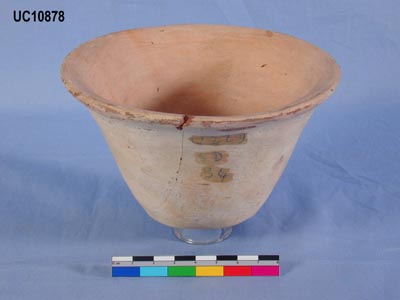HOME / Table of Contents = Civilizations - Cultures - Areas - Regions - Prehistory
Other Archaeological Sites / The Neolithic of the Levant (500 Page Book Online)
Amratian (Naqada I Culture) Period (4000-3500 BC)
NOTE: Naqada is a town on the west bank of the Nile. It stands near the site of a necropolis from the prehistoric and pre-dynastic period circa 4400–3000 BC. The large quantity of remains excavated by Flinders Petrie from Naqada has enabled the dating of the entire culture throughout Egypt and environs ...


 Type-Site Amra (Amirah): Somewhere around 4000 BC at the start of the Egyptian PreDynastic is the Amratian Period or simply Naqada I. The change that is easiest to see in this period is in the pottery. Whereas before ceramics were decorated with simple bands of paint these have clever geometric designs inspired by the world around the artist as well as pictures of animals -- either painted on or carved into the surface of the vessel. Shapes too became more varied both for practical reasons depending on what the vessel was used for and aesthetic reasons. Decorative clay objects were also popular particularly the dancer figurines -- small painted figures of women with upraised arms. Yet perhaps the most important detail of all about this period is the development of true architecture. Like most of Egyptian culture we have gleaned much of our knowledge from what the deceased were buried with and in this case we have several clay models of houses discovered in the graves that resemble the rectangular clay brick homes of the Old Kingdom. This shows that the idea of individual dwellings -- towns -- urban planning started around 4000 BC ...
Type-Site Amra (Amirah): Somewhere around 4000 BC at the start of the Egyptian PreDynastic is the Amratian Period or simply Naqada I. The change that is easiest to see in this period is in the pottery. Whereas before ceramics were decorated with simple bands of paint these have clever geometric designs inspired by the world around the artist as well as pictures of animals -- either painted on or carved into the surface of the vessel. Shapes too became more varied both for practical reasons depending on what the vessel was used for and aesthetic reasons. Decorative clay objects were also popular particularly the dancer figurines -- small painted figures of women with upraised arms. Yet perhaps the most important detail of all about this period is the development of true architecture. Like most of Egyptian culture we have gleaned much of our knowledge from what the deceased were buried with and in this case we have several clay models of houses discovered in the graves that resemble the rectangular clay brick homes of the Old Kingdom. This shows that the idea of individual dwellings -- towns -- urban planning started around 4000 BC ...
The Amratian Culture is named after the site of el-Amra about 120 km south of Badari. El-Amra was the first site where this culture group was found unmingled with the later Gerzean and as such is better attested at Naqada I. Black-topped ware continues to appear but white cross-line ware is also found at this time. Newly excavated objects attest to increased trade between Upper and Lower Egypt at this time. New innovations appeared in Amratian settlements as precursors to later cultural periods. The mud-brick buildings for which the Gerzean period is known were first seen in Amratian times (*) ...
The History of the Ancient Near East Electronic Compendium

